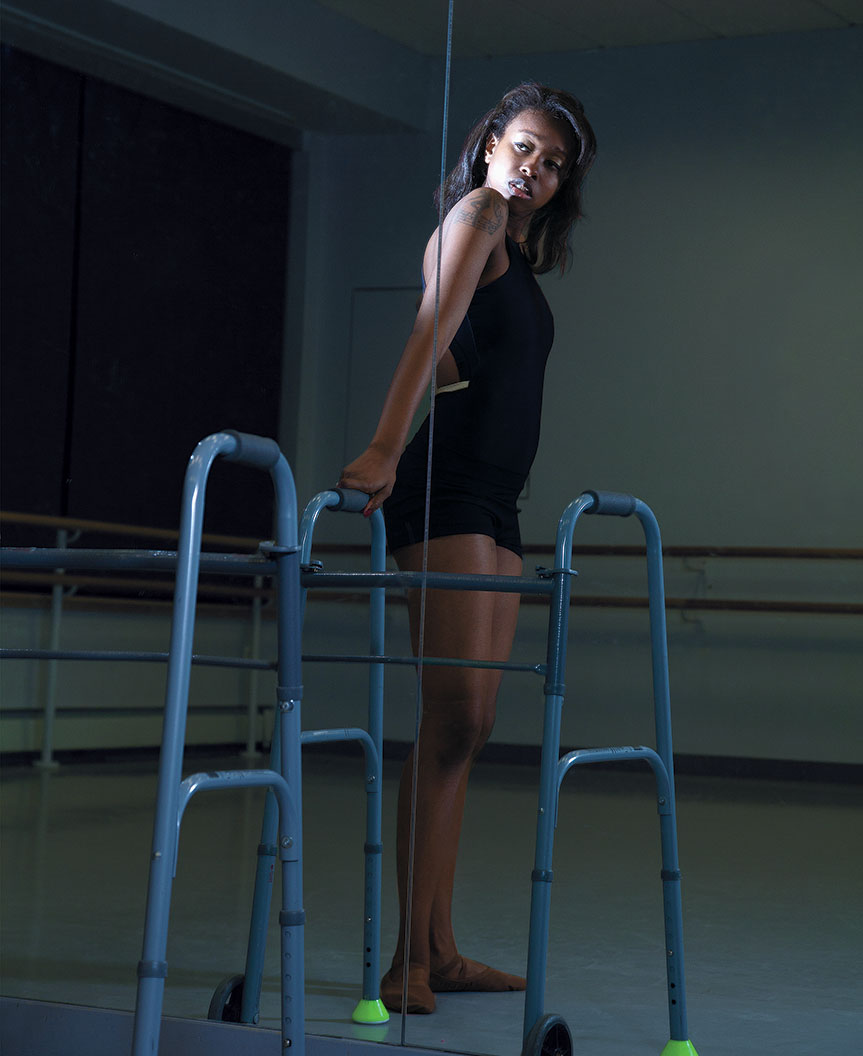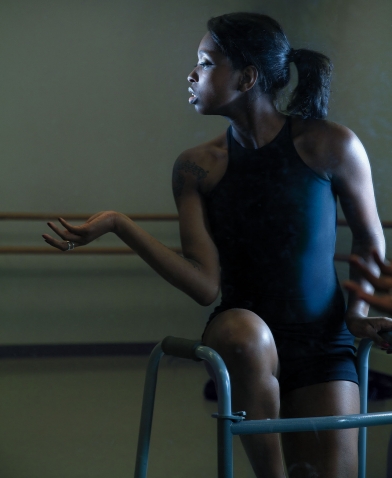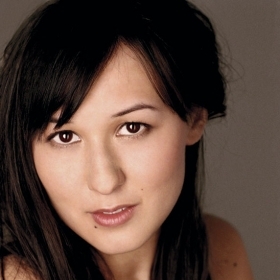It’s 4 p.m. on a Saturday, the last of summer’s golden light spraying off the towering buildings of downtown Manhattan. Inside a sparse white studio lined with mirrors, Ellice Patterson ’16 is down on her hands and left knee, coaching a dancer to fall onto the floor with a loud, yet somehow graceful, thud. It’s the first move in a piece—yet to be named—that will be performed in her company’s showcase next spring.
She tells the dancer to extend her right leg all the way out—a move Patterson readily confesses she can’t execute herself. That’s because she had spinal surgery 10 years ago, which still affects much of her life today—how she moves, walks, and dances.
Patterson took the bus down from Boston to New York just for the day to work with dancers who are based there. For three hours, she choreographs on the fly. Move by move, she coaches her dancers through floor work, spins, and graceful arm movements. Slowly, they add in more dancers and music that she commissioned for the show.
Every now and then, her dancers reveal something new to her—how much pain they are in that day, that it’s hard for one of them to lean fully into a downward dog because she has limited sensation in her hands, and that today’s medication is making it hard to remember the sequence Patterson laid out. Those kinds of admissions—that a move can’t be executed as intended or a modification is needed—might be discouraged at traditional dance studios, but are encouraged in Patterson’s space. Here, they are not limitations to the art that is being created: They are part of it.
Patterson is the executive director of Abilities Dance Boston, a company that has grown to 25 dancers and is welcoming of people of all physical and mental abilities.
It has been nearly 30 years since the Americans with Disabilities Act was passed, mandating that buildings be accessible and prohibiting discrimination against people with disabilities. Opportunities widened, but the creation of fully inclusive, accessible spaces did not happen overnight. And in some cases, it never happened. On this day, Patterson, who uses a walker, had booked a New York studio for her company. The elevators in the building were under construction, sending her up and down the Manhattan block several times to figure out how to get to the upper floors. It’s a small window on the added hurdles people with disabilities still face every day.
Patterson started to dance when she was 4 years old. Raised in rural Mississippi, she says her mom put her in ballet classes to keep her busy. She went to community studios, “hopping around as my mom could afford it,” she says. She was drawn to the “gorgeous music. It had a really nice structure to it.”
But there would be a break in her ability to dance. She doesn’t like to talk about her spinal surgery, but acknowledges it meant an end to dancing for a while—and, she worried, forever.
A few years after her surgery, still unable to dance, she made it from Mississippi to Wellesley, which she describes as a culture shock, but “in a good way.”
“Whether you agreed with them or not, it was nice to have people who were passionate about something,” she says.
She made close friends, says she came into her own queer identity, and felt empowered to know there was disability activism on campus.
Patterson didn’t connect with Wellesley’s Disability Services Office, because she found all the paperwork “really overwhelming, being new to needing resources.” She says she found the hills on campus “really hard,” and relied heavily on the shuttle van service when it became open to everyone at night.

She says she didn’t join any disability communities or organizations on campus but that “it was nice to know it was there—just knowing something was there in case you need it is really powerful.”
Halfway through her time at Wellesley, she dipped her toe back into dance with Yanvalou, a group that performs African dance and folkloric music.
It wasn’t easy. She had to learn a new way of moving, both in her own body and with a new form of dance. “It was harder than I expected as far as mobility and flexibility,” she says, “But it was definitely fun. I got a little bit of the bug again.” Yanvalou, though, was more free-flowing and still a long way from the more formal dance studios she grew up in.
It was a “life-changing” summer that ultimately led Patterson back to dance studios. She sailed across the Atlantic with the Sea Semester program, funded by a Wellesley grant to do biology research. Living on a boat forced her to push past her own expectations for what her body could do. That trip put her “on top of the world, I felt like I could do anything,” she says. “Dance was my next thing.”
When she got back to Boston, she got connected to a local studio and “figured out how to reintegrate back into my body.” She dabbled in ballet, jazz, tap, and modern, and started teaching.
After Wellesley, she tried to find a company to join to dance more regularly. But, she found “literal barriers to entry as far as the dance studios not being ADA compliant.” She remembers “failing hard” at one audition, and asking the director if she could modify her movement or talk to the choreographer beforehand. She was told, “No, it is a professional company.”
“So,” she says, “I created a professional company.”
Patterson had some business school experience, and classmates willing to help, but not a lot of money. So she got a job at a local bar and used her tips to fund her first show. Together with three dancers and four composers who were creating original music for the group, they performed at the Multicultural Arts Center in Cambridge, Mass.
“We just kind of took off from there,” she says.
These days, Patterson is Abilities Dance Boston’s choreographer, marketer, grant writer, and more. She juggles it with a full-time nonprofit job, but hopes to make it her full-time commitment.
Her organization now comprises the professional performing company, as well as a community engagement and education program. The dancers audition to join the company. Some dance part time, because Abilities is the only place they have the opportunity. Others dance full time, including for other companies. Patterson says her budget is too small to pay her dancers a salary, but she does give them an honorarium whenever she is able to.
She prides herself on getting to know her dancers, and encouraging their collaboration to create pieces that speak to them and the audience. The dancers in Abilities Dance Boston, with and without disabilities, have been excited to be involved in the choreographic process “so that the movements are true to their bodies,” Patterson says.
Leslie Freeman Taub, one of the dancers, says that adapting and modifying movement is essential to physically integrated dance. She describes Patterson as a “driven, ambitious young artist” with an “intuitively intersectional” aesthetic. “Ellice’s youth and soft-spoken personality lends her choreographic process a kind of approach ability,” she says.
In a piece titled Boss Women, dancers wore shirts depicting feminist icons like Frida Kahlo. In one improvisational piece called Journeys, Patterson performed with her walker on stage.
The company has performed at the Museum of Fine Arts, the Peabody Essex Museum, the Boston Contemporary Dance Festival, and more. Patterson was named as part of “Boston’s New Creative Guard” by Boston magazine.
Patterson is currently working on her company’s March 2020 showcase. She’s finished one piece, called Spiraling Out, which is inspired by “that mode of life where I feel like everything is spiraling out and nothing is concrete, and things are hard.”
When not performing, she and volunteers conduct programs on disabilities rights and making spaces more inclusive.
“To have a company founded by a black woman with a disability in a world that is traditionally white, is a movement in and of itself,” Patterson says. “We’re just changing the game in different ways.”
As Abilities Dance Boston grows, Patterson hopes it will bring in the greater Boston community—through dance and education—to create a better understanding of disability culture.
Her hope for her dancers, in some ways, is much simpler, but equally consequential. “I hope that they continue to shine their light,” she says, “and tell their truth with their movements.”








We ask that those who engage in Wellesley magazine's online community act with honesty, integrity, and respect. (Remember the honor code, alums?) We reserve the right to remove comments by impersonators or comments that are not civil and relevant to the subject at hand. By posting here, you are permitting Wellesley magazine to edit and republish your comment in all media. Please remember that all posts are public.